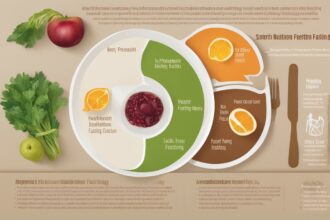Hey there, fasting enthusiasts! If you’ve been exploring the world of fasting—whether for health, spiritual reasons, or weight management—you’ve likely heard about the importance of refeeding. Breaking a fast isn’t as simple as diving into a buffet; it’s a delicate process that requires care to avoid health risks and maximize benefits. In this comprehensive guide, we’re diving deep into refeeding tips to help you transition back to regular eating safely and effectively. Whether you’re new to fasting or a seasoned pro, these science-backed strategies and practical insights will ensure your body gets the nourishment it needs without the shock. Let’s explore how to refeed smartly, why it matters, and what pitfalls to avoid during this critical phase.
Why Refeeding Matters: Understanding the Risks
Refeeding after a fast isn’t just about satisfying hunger—it’s about protecting your body from potential harm. When you fast, especially for extended periods, your digestive system slows down, and your body shifts into a state of conservation, reducing metabolic activity and altering electrolyte balances (Gibson et al., 2016). Suddenly reintroducing food, particularly in large amounts or with the wrong nutrients, can overwhelm your system. This can lead to a dangerous condition known as refeeding syndrome, characterized by severe electrolyte imbalances, fluid shifts, and even organ failure in extreme cases (Mehanna et al., 2008). So, before we get into actionable refeeding tips, let’s understand why a strategic approach is non-negotiable. Proper refeeding helps stabilize blood sugar, replenish nutrients, and prevent digestive distress, ensuring your fasting efforts don’t go to waste.
Timing Your Refeed: When and How to Start
One of the first questions people ask is, “When should I start eating again after a fast?” The answer depends on the type and duration of your fast. For shorter fasts, like intermittent fasting (16:8 method), refeeding can begin with your usual meal window, but it’s still wise to ease in gently. For longer fasts—think 24 hours or more—experts recommend a gradual reintroduction over 1–3 days, depending on the fast’s length (Crook et al., 2001). Start with small, nutrient-dense meals to “wake up” your digestive system. A good rule of thumb is to begin with liquid or semi-solid foods, like broths or smoothies, before progressing to solids. Timing your refeed also means listening to your body—if you feel lightheaded or nauseous, slow down. These post-fast nutrition strategies ensure your body isn’t shocked by sudden caloric intake.
What to Eat: Nutrient Priorities for Safe Refeeding
Choosing the right foods is at the heart of effective refeeding tips. After a fast, your body craves specific nutrients to restore balance, particularly electrolytes like potassium, magnesium, and phosphate, which can be depleted during fasting (Mehanna et al., 2008). But don’t rush to load up on heavy or processed foods—your stomach isn’t ready for that yet. Here are some key food choices to prioritize during the initial refeeding phase:
- Bone Broth or Vegetable Broth: These are gentle on the stomach, hydrating, and rich in minerals to support electrolyte balance.
- Soft Fruits: Think bananas or avocados, which provide potassium and healthy fats without overwhelming digestion.
- Cooked Vegetables: Steamed carrots or zucchini are easy to digest and offer essential vitamins.
- Small Portions of Lean Protein: After a day or two, introduce eggs or fish to rebuild muscle without taxing your system.
Avoid high-sugar, high-fat, or processed foods during the first few meals, as they can spike blood sugar and cause gastrointestinal distress (Gibson et al., 2016). Focus on safe refeeding practices by keeping portions small and meals balanced.
How Much to Eat: Portion Control and Pacing
One of the biggest mistakes people make when breaking a fast is overeating. I get it—after hours or days of not eating, that pizza looks incredibly tempting! But gorging can lead to bloating, nausea, or worse, refeeding syndrome in extreme cases (Crook et al., 2001). A key piece of advice among refeeding tips is to start with about 25–50% of your usual caloric intake on the first day post-fast, gradually increasing over 2–3 days. For example, if you normally eat 2,000 calories, aim for 500–1,000 calories on day one, split into small, frequent meals. Chew slowly, sip water between bites, and stop if you feel full. Pacing yourself during this breaking a fast guide ensures your digestive enzymes and gut bacteria have time to readjust without being overwhelmed.
Common Mistakes to Avoid During Refeeding
Even with the best intentions, it’s easy to slip up during refeeding if you’re not aware of the pitfalls. Let’s walk through some common mistakes and how to dodge them with practical refeeding after fasting advice. First, skipping hydration—water is your best friend post-fast to restore fluid balance and support digestion (Institute of Medicine, 2005). Second, jumping into complex meals too soon—steer clear of heavy carbs or fried foods until your system is ready. And third, ignoring symptoms like dizziness or heart palpitations, which could signal electrolyte issues. If you experience these, consult a healthcare provider immediately. Here’s a quick checklist of errors to avoid:
- Eating Too Quickly: Rushing meals can strain your stomach; take your time.
- Ignoring electrolytes: Don’t skip mineral-rich foods or supplements if needed.
- Overlooking Portion Size: Stick to small meals to prevent digestive shock.
- Neglecting Rest: Give your body energy to heal by avoiding overexertion post-fast.
Special Considerations: Who Needs Extra Care?
Not everyone can follow the same refeeding tips—some individuals need tailored approaches due to health conditions or fasting duration. If you’ve fasted for over 5 days, have a history of eating disorders, or suffer from malnutrition, refeeding should be medically supervised to prevent complications like refeeding syndrome (National Institute for Health and Care Excellence, 2006). Similarly, people with diabetes or heart conditions should monitor blood sugar and electrolyte levels closely during post-fast recovery. Pregnant or breastfeeding individuals should avoid prolonged fasts altogether, but if refeeding after a short fast, they must prioritize nutrient-dense foods to support both themselves and their baby. Always consult a doctor or dietitian if you’re unsure about your specific needs—personalized fasting recovery tips can make all the difference.
Wrapping up, refeeding is a crucial step that can make or break the benefits of your fasting journey. By following these refeeding tips, you’re not just breaking a fast—you’re setting the stage for long-term health and vitality. Remember to start slow, prioritize nutrient-rich foods, stay hydrated, and listen to your body’s signals. Fasting can be a powerful tool, but only if you transition back to eating with intention and care. So, take these strategies to heart, experiment with what works for you, and don’t hesitate to seek professional guidance if needed. Here’s to safe and successful refeeding—your body will thank you! Have any personal refeeding experiences or questions? Drop them in the comments below; I’d love to hear from you.
References
- Crook, M. A., Hally, V., & Panteli, J. V. (2001). The importance of the refeeding syndrome. Nutrition, 17(7-8), 632-637. https://doi.org/10.1016/S0899-9007(01)00542-1
- Gibson, R. S., Bailey, K. B., Gibbs, M., & Ferguson, E. L. (2016). A review of phytate, iron, zinc, and calcium interactions in the context of plant-based diets. Nutrition Reviews, 74(2), 77-89. https://doi.org/10.1093/nutrit/nuv047
- Institute of Medicine. (2005). Dietary Reference Intakes for Water, Potassium, Sodium, Chloride, and Sulfate. National Academies Press. https://doi.org/10.17226/10925
- Mehanna, H. M., Moledina, J., & Travis, J. (2008). Refeeding syndrome: What it is, and how to prevent and treat it. BMJ, 336(7659), 1495-1498. https://doi.org/10.1136/bmj.a301
- National Institute for Health and Care Excellence. (2006). Nutrition support for adults: Oral nutrition support, enteral tube feeding and parenteral nutrition. NICE Guideline CG32. https://www.nice.org.uk/guidance/cg32






